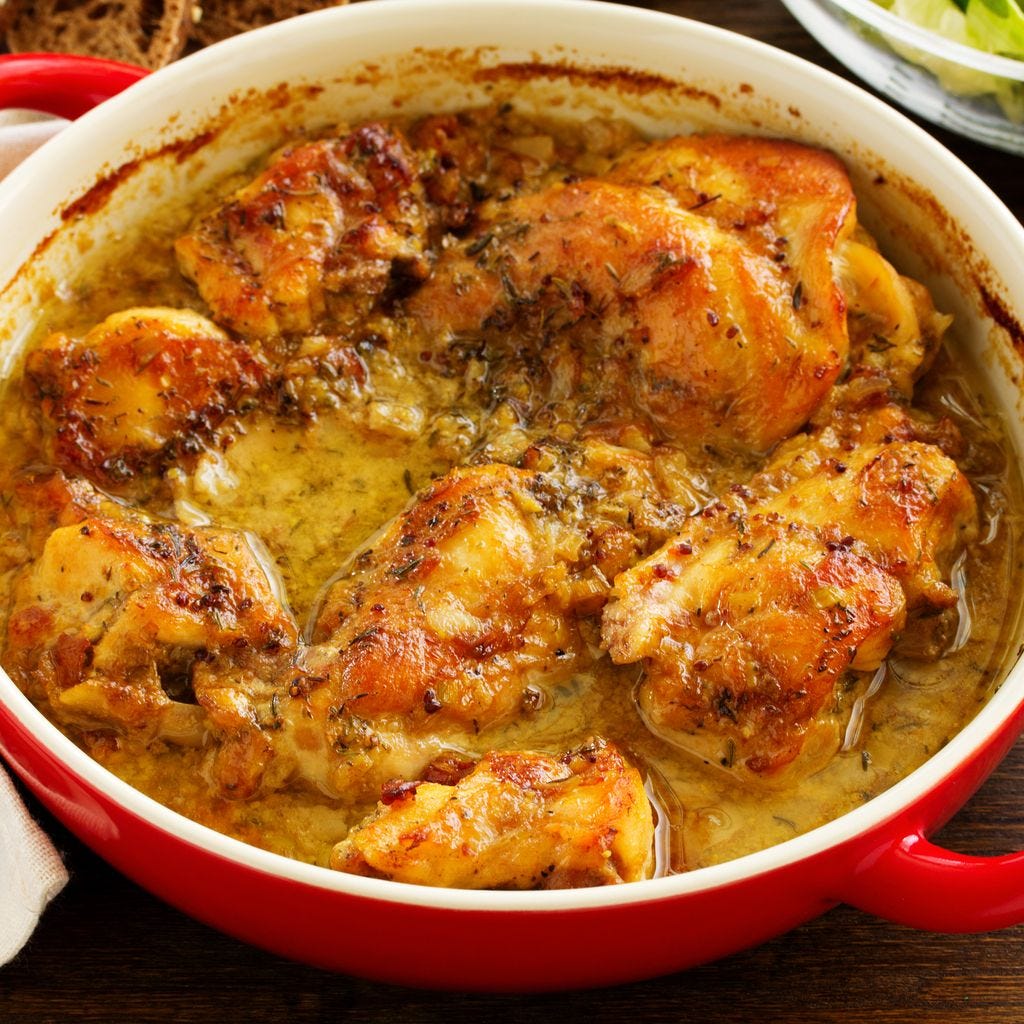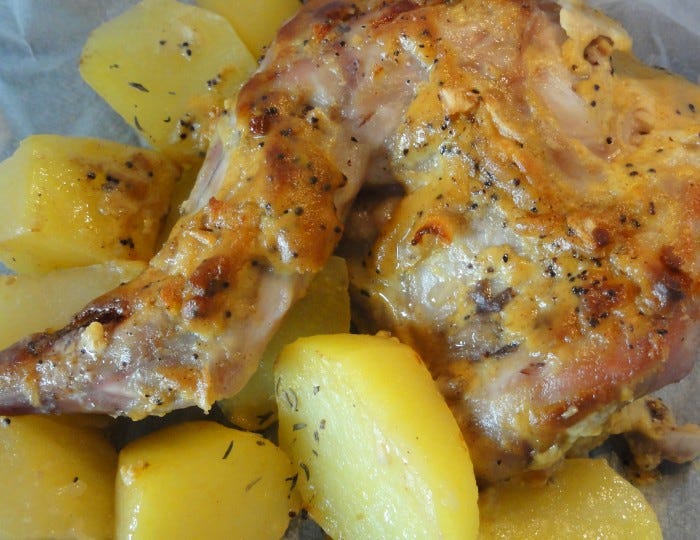Lapin à la Moutarde: Eating Close to Home in France
From Bodegas to Butchers: Cooking What’s Around Instead of Chasing What’s Not
One of the first things I noticed after moving to a smaller city in France was how much the food reflected the place itself. There’s a strong emphasis on local and seasonal ingredients - not in a trendy, farm-to-table way, but as a natural part of how people eat. The supermarket carries produce from nearby farms, the butcher has meat sourced from the region, and the market shifts with the seasons. There are fewer choices in some ways - you won’t find blueberries in March or strawberries year-round-but there’s a depth of variety rooted in what actually grows here.
Abundant, until it’s not
In New York, I could get almost anything, anytime, even if quality seriously varied. Those flavorless strawberries, even the frozen ones. A banana from Ecuador, an apple from Washington State, a chicken raised on organic quinoa and meditation, delivered to my apartment with a click. There’s a kind of simplicity in that convenience - or ease at least - having whatever you want, whenever you want it.
A friend of mine even had a “cookbook” for parties: a massive binder full of takeout menus spanning at least 30 cuisines, kosher versions included. It was fun.
But as anyone who has lived through a hurricane, a pandemic, or a blizzard in NYC knows, that sense of abundance is an illusion. It only takes one disruption—a storm, a supply chain breakdown—for it all to unravel. When Hurricane Sandy knocked out power in lower Manhattan for weeks, gas stations in Brooklyn had mile-long fuel lines.
During the early days of the pandemic, the city emptied at night, eerily quiet. The stillness was peaceful in a way, but it was also a reminder: when the system slows down, when the trucks stop coming, the shelves empty fast.
Rabbit, Right Next to the Chicken
I think supply chains are both shorter and food options more diverse in France, and nothing illustrates this better than Mustard Bunny—a dish that is easier in every conceivable way to make here than in the U.S.
Rabbit is also much more sustainable, especially when compared to industrial farmed chicken, the length of shipping time, the way they’re raised, and so on. It’s terrible.
There’s simply more variety in meats. One of the first things I noticed at the butcher was the rabbit, but there are more diverse options here.
Back in the U.S., rabbit is a niche meat at best. You might find it at a high-end butcher or that one eccentric farm stand at the greenmarket, but it’s hardly a staple.
In France, rabbit sits right next to the chicken, pork, and beef. It’s not something everyone eats every day, but it’s just another dinner option—nothing unusual, nothing difficult to source, just food. I mean, if you’re going to eat meat, it’s good to diversify your options.
This isn’t just about rabbit—it’s about how different cultures maintain (or lose) their connection to diverse, local food sources. In the U.S., industrial agriculture has streamlined what we eat into a few dominant proteins: beef, pork, and chicken.
Despite being lean, sustainable, and widely farmed, rabbit never quite fit into the factory-farming model. In the U.S., it remained a food of the past—something associated with the Great Depression, or even fine dining, or some old-world tradition that never quite made it into the mainstream.
Americans also tend to see rabbits as pets, and, well, people don’t eat their pets.
In New York, protests against the sale of rabbit meat are common. No one likes to think too hard about the personality of their dinner, but rabbits make it especially difficult—they’re famously cuddly, intelligent, and can even learn tricks.
If anyone in France is teaching them tricks, it is not readily in evidence at the deli counter.
In France, rabbit never disappeared from the table. People still cook lapin à la moutarde—rabbit in mustard sauce—without a second thought. In fact, when I mentioned that I cooked a rabbit to a French friend, he asked if I cooked that recipe.
It’s not exotic, it’s not fancy.
It’s just food.
The Rhythm of Cooking with What’s There
One of the things I’ve come to appreciate in France is the rhythm of food. You might not find blueberries in March, but you will find whatever is in season from nearby farms. The variety isn’t about how many options you have at a given moment, but how the options change throughout the year.
Which brings me back to rabbit.
Back in New York, making this dish was a pain—pesky silver skin, unappealing fat, and butchers who rarely prepared them well. Rabbits were usually sold whole, meaning I had to handle the butchery myself.
In France, lapin à la moutarde is effortless—local ingredients, slow cooking, deep flavor. The rabbit comes cleaned and sectioned, ready for the pot. In the U.S., without a good butcher, sourcing one is a hassle—either a special order or doing the work yourself.
When things are set up like this, it feels a bit like cheating because it’s so simple to do. And it’s inexpensive here. At my local Leclerc, I can buy a whole rabbit, already cleaned and sectioned, ready for the pot.
Although it does seem that there are some supermarkets that offer rabbits both as pets and food here.
I’d just suggest separate shopping trips.
Recipes and serving suggestions
Instead of a recipe, I’m just including sources I liked for this and some notes.
For rabbit in general and a guide, Alan Bergo’s Forager Chef is a great resource. His breakdown of how to prep wild rabbit is worth a read: Forager Chef: Rabbit Chasseur.
For those who just want to cook, Hank Shaw’s version of lapin à la moutarde is a great reference: Simply Recipes: Rabbit in Mustard Sauce.
And, for a good French take, this one from Au Fil du Thym is a solid guide: Lapin Moutarde à l'Ancienne.
But honestly, the process is simple.
Notes: How to Make Lapin à la Moutarde
Take a rabbit. Cut it into pieces.
Sear it. Brown it in butter, then take it out.
Build the sauce. Add shallots and garlic, deglaze with white wine, then drown everything in stock.
Simmer. Let it go low and slow for 90 minutes.
Finish with mustard and cream. Serve with root vegetables—mashed turnips or parsnips are ideal.
This is the kind of dish that fits a place with shorter supply chains, where meals rely on what’s available, not what’s shipped from half a world away. There’s a deep comfort in that—cooking with what’s here, not chasing the illusion of endless choice.
Thanks for Reading (and Cooking Along)
I know there’s no shortage of things to read, watch, and scroll through, so thanks for spending some of your time here. I try to make it worth it—something interesting, something you won’t find everywhere else, something fueled by my own (sometimes obsessive) curiosity.
If you make the lapin à la moutarde, let me know how it goes. If you have thoughts, questions, or things you’d like to see more of, drop a comment. And if you want to help keep this going, you can buy me a coffee here—it keeps me writing, and maybe makes it better for you, too.
More soon. And thanks, as always, for reading.
K







I am so hungry now, and there aint no rabbit in Istanbul
I have now secured a Lapin for weekend eating. The local butcher had one although they don't display them.